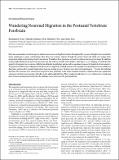Wandering Neuronal Migration in the Postnatal Vertebrate Forebrain
Author(s)
Scott, Benjamin B.; Gardner, Timothy; Ji, Ni; Fee, Michale S.; Lois, Carlos
DownloadFee-2012-Wandering Neuronal.pdf (6.398Mb)
PUBLISHER_POLICY
Publisher Policy
Article is made available in accordance with the publisher's policy and may be subject to US copyright law. Please refer to the publisher's site for terms of use.
Terms of use
Metadata
Show full item recordAbstract
Most non-mammalian vertebrate species add new neurons to existing brain circuits throughout life, a process thought to be essential for tissue maintenance, repair, and learning. How these new neurons migrate through the mature brain and which cues trigger their integration within a functioning circuit is not known. To address these questions, we used two-photon microscopy to image the addition of genetically labeled newly generated neurons into the brain of juvenile zebra finches. Time-lapse in vivo imaging revealed that the majority of migratory new neurons exhibited a multipolar morphology and moved in a nonlinear manner for hundreds of micrometers. Young neurons did not use radial glia or blood vessels as a migratory scaffold; instead, cells extended several motile processes in different directions and moved by somal translocation along an existing process. Neurons were observed migrating for ∼2 weeks after labeling injection. New neurons were observed to integrate in close proximity to the soma of mature neurons, a behavior that may explain the emergence of clusters of neuronal cell bodies in the adult songbird brain. These results provide direct, in vivo evidence for a wandering form of neuronal migration involved in the addition of new neurons in the postnatal brain.
Date issued
2012-01Department
Massachusetts Institute of Technology. Department of Brain and Cognitive Sciences; McGovern Institute for Brain Research at MITJournal
Journal of Neuroscience
Publisher
Society for Neuroscience
Citation
Scott, B. Benjamin et al. "Wandering Neuronal Migration in the Postnatal Vertebrate Forebrain" The Journal of Neuroscience, January 25, 2012 32(4):1436–1446.
Version: Final published version
ISSN
0270-6474
1529-2401